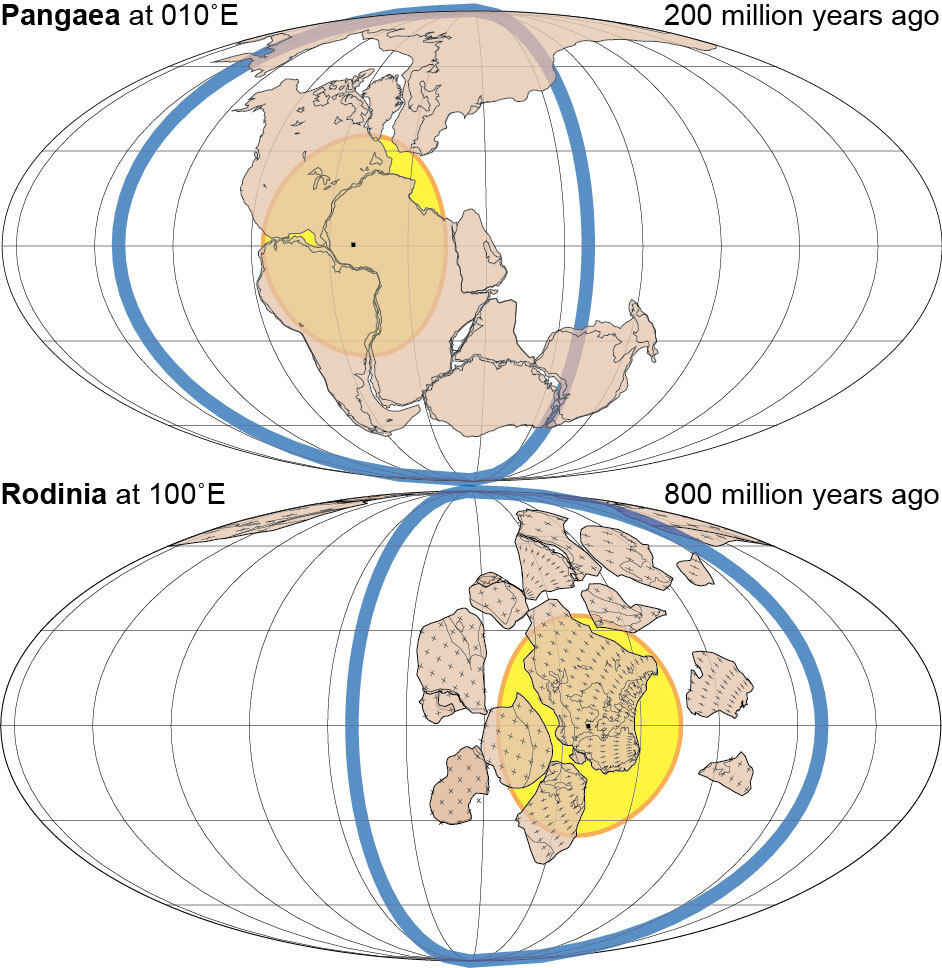When Will the Continents Unite Again
The Earth's continents are in abiding movement. On at to the lowest degree three occasions, they have all collided to class one giant continent. If history is a guide, the electric current continents volition coalesce over again to grade another supercontinent. And a study in Nature now shows how that could come up about.
You can recollect of continents every bit giant puzzle pieces shuffling around the Earth. When they drift apart, mighty oceans form. When they come together, oceans disappear. And information technology'southward all considering continents sit on moving plates of the World's chaff.
A new model of continental migrate predicts that the side by side supercontinent could form near the North Pole — in another 100 million years or and so.

2 of the previous supercontinents, which formed 200 meg years ago (Pangaea) and 800 1000000 years ago (Rodinia). Mitchell, et. al./Nature hide explanation
toggle caption
Mitchell, et. al./Nature

Two of the previous supercontinents, which formed 200 million years agone (Pangaea) and 800 million years ago (Rodinia).
Mitchell, et. al./Nature

The Americas and Asia may fuse together to form a new supercontinent, "Amasia." Mitchell, et. al./Nature hide caption
toggle caption
Mitchell, et. al./Nature

The Americas and Asia may fuse together to form a new supercontinent, "Amasia."
Mitchell, et. al./Nature
"Continents on these plates typically motility, I would say, at the rate your fingernails abound," says Ross Mitchell, a graduate student at Yale University. That may seem ho-hum, but it adds up over hundreds of millions of years.
Await at an atlas and yous tin can imagine how Africa and Due south America, for example, one time nestled together.
"Rewind the tape and bring all the continents back into their jigsaw organisation, yous have this vast landmass of all the Globe's continental blocks together," Mitchell says.
Last time all the landmass clumped upwardly, information technology formed a supercontinent called Pangaea. The dinosaurs walked there. Just Pangaea wasn't the starting time.
"There had been three, possibly a debated fourth supercontinent through the billions of years," Mitchell says.
He has been studying that deep history by looking at tiny magnets buried in rock effectually the earth. Those magnets pointed northward when they were locked into the rock. Sample those magnets in layers of rock laid downward over millions of years, and you lot tin tell the story of how those continents take moved.
And naturally, that led Mitchell to wonder what the next supercontinent will expect like.
There have been two leading ideas. One is that the continents will collapse together once again at the site of the last supercontinent, centered on Africa. That would squeeze the Atlantic Ocean shut. The other idea is that the Atlantic would go along growing and growing.
Under this scenario, "a supercontinent rifts apart, and the continents skirt around to the opposite side of the globe, re-creating the next supercontinent, 180 degrees on the opposite side of the world from the previous one," Mitchell says.
That would leave united states with a supercontinent in place of the Pacific Body of water.
A Supercontinent Called Amasia
Just Mitchell'southward research for his Ph.D. thesis suggests both those ideas are incorrect. Instead, he says the continents seem to be moving n. That ways the Caribbean Bounding main and the Arctic Body of water volition exist squished close.
"Think well-nigh closing the Caribbean area Sea — you take now fused North and Southward America," Mitchell says. "And so by fusing the Arctic Sea, you would suture the Americas with Eurasia."
850 1000000 Years Of Drifting
The state on Earth is moving, merely slowly — well-nigh as fast every bit your fingernails grow. If we turn the clock dorsum 850 million years, we tin can see how the continents grew apart and back together several times.
That would create a supercontinent chosen Amasia that would form at the top of the Globe. Eventually it would slump south toward the equator. And under this scenario, Antarctica might remain isolated at the bottom of the earth.
Brendan Murphy studies supercontinents at St. Francis Xavier University in Nova Scotia. He says the Yale team'southward idea is provocative, innovative and plausible.
"What they've washed is they've thrown another possibility out there that, quite frankly, many of the states hadn't really thought about. So even if the model is wrong, nosotros will acquire a lot by testing it."
And he says the challenge isn't simply finding unlike ways to put together the Earth's jigsaw puzzle continents.
"This is really important because it influences the evolution of our unabridged planet, including life that lives on it," Murphy says. "For case, many people believe that supercontinents form and stood apart their cardinal changes in climate."
Of grade, the side by side supercontinent isn't likely to form for another 100 million years or so. And Mitchell says the homo species will probably be long gone past then, and then nosotros won't know, "merely it'southward certainly fun to think about."
Source: https://www.npr.org/2012/02/08/146572456/amasia-the-next-supercontinent
0 Response to "When Will the Continents Unite Again"
Post a Comment